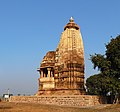Ratha (architecture)
The term Ratha (in Odisha also rāhā ) denotes the structure of the outer wall of the cella ( garbhagriha ) of an Indian temple ; it is regularly continued in its tower structure ( shikhara or deul ). The interior of the cella, on the other hand, is often not structured. As the rathas increased in number, the floor plans of the cella and tower developed from an originally square (more rarely rectangular) shape to an approximately round shape.
etymology
In Sanskrit ratha refers to a wooden chariot, as it is still used today at some east and south Indian festivals ( ratha yatra ).
A distinction is made between three-part ( triratha ), five-part ( pancharatha ), seven-part ( saptaratha ) and nine-part ( navaratha ) outer wall structures. Numerous other projections and recesses as well as niches and vertically arranged decorative and decorative ribbons often make the clear identification of the outer wall structure of later Indian temples complicated.
history
The oldest open-air temples in North India were towerless and not structured (cf. Tigawa , Kunda , Sanchi , Nachna , Naresar , Talagunda etc.). The Dashavatara temple of Deogarh ( Uttar Pradesh ), built around 500 AD , on the other hand, already shows a clear triratha outer wall structure, which has probably continued in the roof structure. Under the Gurjara Pratiharas the number of structural elements increases significantly and Shikhara towers become the rule (cf. Naresar, Bateshwara , Amrol , Gyaraspur ). In the monumental buildings of the Chandella in Khajuraho or individual temples like that of Udaipur ( Madhya Pradesh ), the Hindu temples reach their architectural climax.
Tigawa , Kankali Devi Temple (around 420)
Deogarh , Dashavatara Temple (around 500)
Amrol , Ramesvara Mahadeva Temple (around 750)
Gwalior , Teli-ka-Mandir (around 770)
Udaipur ( Madhya Pradesh ), Nilakanteshwara Temple (around 1100)
Khajuraho , Chaturbuja Temple (around 1120)
See also
Overall, the ever increasing division and thus the dissolution of the outer walls of a Hindu temple corresponds to similar design principles of the somewhat later European Gothic . Whether there are any relationships or whether it is an (art) historical coincidence has not yet been investigated.
literature
- Michael W. Meister, MA Dhaky, Krishna Deva (Eds.): Encyclopaedia of Indian Temple Architecture. North India - Foundations of North India Style (approx. 250–1100) . Princeton University Press 1988, ISBN 0-691-04053-2
- Michael W. Meister, MA Dhaky (Ed.): Encyclopaedia of Indian Temple Architecture. North India - Period of Early Maturity (approx. 700–900) . Princeton University Press 1991, ISBN 0-8122-7840-2





